
Mon-Fri: 8am-5.30pm
Sat: 8:30am-1:00pm
Sun: Closed
339 Bedworth Road,
Longford, Coventry, CV6 6BN.
Tel: 024 7636 6177
Email: dom@powersperformance.co.uk
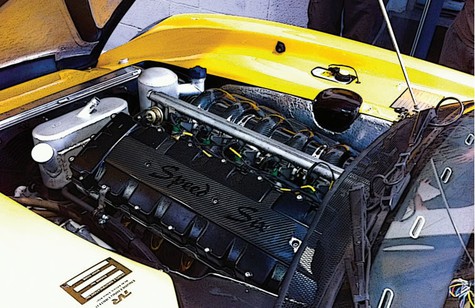 }
}
It is incredibly five years since Powers Performance announced the launch of its 4.3 litre Speed 6 engine conversion.The goal at the time wasto develop a 4.3 litre Speed 6 unit which would be as smooth, reliable and punchy as their highly respected and much loved 4.3 litre Rover V8 unit. The Rover V8 4.3 over the years had gained almost cultstatus amongst Chimaera and Griffith owners and Power wanted to create the same feeling with their 4.3 Speed 6 amongst the ‘T’ car and Cerbera fraternity. Five years down the road they appear to have succeeded.
With 195 conversions completed and no major mechanical failures to report, the Powers Performance 4.3 Speed 6 conversion has proved to be a very popular and much sought-after upgrade. The company has a continuous flow of 4.3 units through its engine building room and moving forward a very healthy looking order book.With the high demand for this ever popular conversion complimented by excellent customer feedback, we have surely witnessed the birth of a true modern classic.
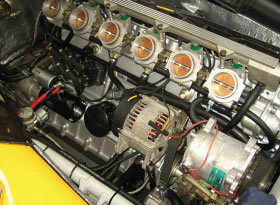 When Power first announced their 4.3 Speed 6, there were those who considered they were on a hiding to nothing. And you have to say the naysayers had a point. After all,the Speed 6’s reliability record thusfar hadn’t been the most impressive. However Power’s excellent development history coupled with its undoubted engineering expertise meant that their first Speed 6 conversion could only be a roaring success and five years on that has proved to be the case.
When Power first announced their 4.3 Speed 6, there were those who considered they were on a hiding to nothing. And you have to say the naysayers had a point. After all,the Speed 6’s reliability record thusfar hadn’t been the most impressive. However Power’s excellent development history coupled with its undoubted engineering expertise meant that their first Speed 6 conversion could only be a roaring success and five years on that has proved to be the case.
Dom Trickett, Managing Director of Powers Performance comments“ We could see huge potential in developing the Speed 6 unit further and were happy we had solved the early reliability issues experienced with many of the Factory fitted engines. So it was natural for us to develop the engine one step further and to see how much reliability we could build into it.”
Power’s standard practice of a lengthy development programme including a gruelling and lengthy testing schedule meant that when they announced the 4.3 conversion, they had already spent two years developing the unit. With an approach like that, which includes a sizable investment,you can be pretty sure that the finished product will be the real deal.
However in true Power fashion they were already looking for more, so when the 100th 4.3 conversion rolled out of the workshop they decided to take the Speed 6 one step further. They started development work on the 4.5. Now you would think that offering a 4.5 alongside the 4.3 would merely dilute the existing market, but the contrary was to prove to be the case. In actual fact the emergence of the 4.5 option merely enhanced the reputation of the ultra-reliable 4.3 and sales continued to grow. And whilst Power’s 4.5 option was released comparatively recently, 24 conversions have been completed to date and again the order book is looking healthy.
Danny Winstanley’s outingsin last season’s GT Cup in the Team Winstanley 4.5 litre powered Sagaris also proved Power’s latest conversion to be reliable, even in the extremes of a race environment. So with 4.3 and 4.5 firmly established it was time for Power to move it up another gear. With a good amount of tolerance still left in the block, Power decided the third and final step would be to take the Speed 6 unit to its ultimate conclusion and develop a 5.0 litre version.
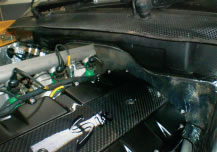
Dom continues “The reliability of the 4.3 and 4.5 impressed us greatly and the feedback we received from our customers cemented the fact. So we decided to take the Speed 6 as far as we could as an engineering exercise to see for ourselves how far we could develop the unit.The results so far have been very impressive.”
Power’s development 5.0 litre Speed 6 uses the same stock valve train asthe 4.0, 4.3 and 4.5 litre engines, with a modified cam timing combination. To gain the extra capacity the 5.0 litre uses the same bore as the 4.5, but isfitted with a custom made Powers Performance stroker crank. This in turn is complimented by new, shorter H section rodsfeaturing modified pin positions.
The ultimate Speed 6 engineering exercise, Power’s new 5.0 litre test engine has already covered over 3,000 milesin Dom’s development Sagaris and so far everything is looking good; well, pretty much.
Dom explains:
The 5.0 litre’s reliability so far has been perfect and the power the engine produces is astounding.
But in actual fact there is so much power at the rear wheels, there is now an argument as to whether we fit traction control to the car to aid drivability.
Let’s just say in the wet it is character building. And I wouldn’t rule out launch control either. This is one of the fastest cars I have ever driven and getting it away without spinning up the rear wheelsis almost impossible.” Power’s current 5.0 litre development and testing programme is by no way meant to herald the release of yet another Powers Performance upgrade. But the experience gained from taking the Speed 6 to its ultimate conclusion will help the company build additional reliability into its existing engine options which at the end of the day can only benefit their army of loyal customers.
Indeed with a good amount of data from the 5.0 litre test engine now having been analysed, Power is taking the project on a step further and is currently moving into stage two of their 5.0 litre development. Dom explains “Stage two takes our crankshaft and con-rod combination on a step, building into the engine even more reliability whist developing even more power. Put simply; as an engineering exercise I want to make a reliable, high revving 5.0 litre which will make huge numbers to show what the Speed 6 isreally capable of. So watch this space.” On a lighter note it hasn’t escaped my notice that over the pastseven years of Speed 6 evolution, Dom’s development Sagaris has generally been fitted with a bigger engine than anyone else’s.
If this Managing Director’s car also happened to be fitted with a full race roll-cage I would be tempted to tell him to paint it reflex green and stick a number 8 on the side! Although I can think of one group of driversI know rather well who are no-doubt delighted that it isn’t and he won’t. The good newsisthat once Dom’s engines developments have been fully proven and released as a Powers Performance upgrade, we can be powered by exactly the same thing.
So Dom’s broad grin today is our broad grin tomorrow.
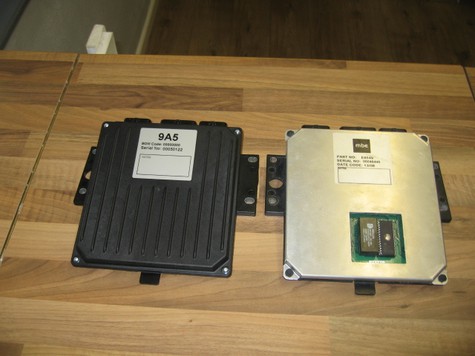 }
}
MBE was founded in 1987 in order to provide powertrain control systems during a time of intense technological change within motorsport. The techniques MBE employed enabled rapid development of the company and to the subsequent growth of MBE Systems.
MBE has built its reputation by harnessing its significant technical expertise with an impressive "can-do" approach to every project undertaken - a success story proved over and again. MBE deliver:
- Fast Response - often outpacing client deadlines
- Highly Competitive - in development and production costs
- Bespoke Systems - designed to meet the most exacting standards
- Experience - valuable advice and consultancy at every stage
- Innovation - in design and performance which exceed client expectations
The collective goal at MBE is to enable the development of the best technical innovations within the powertrain industry, whether that goal is cleaner environment, reduced weight or more power. The MBE team is continually developing unique diagnostic software systems and revolutionizing the design and manufacturing processes associated with emission-legislation compliance. The key benefits to clients being increased speed in design and development and reduced production costs.
The sophisticated technological advances made by the company have led to MBE being regular partners in the development programs of Engine Management systems for some of the world's leading automotive companies for production vehicles, R&D applications, military applications and motor sport clients.
MBE first started to work with TVR in the early 1990s where the synergies between the two outward looking and innovative companies led to a long and successful partnership. Numerous innovations enabled TVR to produce road going emission legal cars with exceptionally high specific power outputs at far lower cost than contemporary competitors.
The recent turmoil at TVR have resulted in many of these projects lying dormant and rather than let these projects fade into memory, MBE and TVR Power have decided to blow the dust away and let TVR drivers experience some of the features that only that original thinking mentality of that TVR era would have produced.
The features that were near to production were:
Enhanced Logging capability
Euro 6 emissions compliance
Encompassing Drive by Wire
Wide band Fast Light Off Lambda Control
Variable CAM control
Knock Control
Throttle body Production variance compensation strategies
ESP/Traction Control
Automated Transmission
Knock Suppression Strategies
Flat Shift Functions
Optional Data Display – ( lcd screen)
Plug & Play to fit stand wiring harnesses
No more Eprom Chips
http://www.mbesystems.com/
The TVR Power Pro Stock Bike team have had a number of challenges this year, but rider and tuner Dave Beck goes into the final major event of the year feeling confident. The year opened well with a European best run of 7.06 seconds at the Easter meeting. The 1755cc, 350bhp Suzuki suffered some engine damage, but hung on to take the win. The next event was the UEM Main Event at Santa Pod, but we suffered more motor damage before even turning a wheel in anger. The summer saw Dave ride a Finnish owned bike in the European rounds in Finland and Sweden, and while this wasn’t on the TVR Power bike, some valuable data was collected which will be put to good use in the future.
For 2011 there is one remaining round of the UEM Championship left, at the European Finals at Santa Pod in the UK. 25,000 spectators are expected on the qualifying and race days, as the best European drag racers on two and four wheels do battle. The Pro Stock bike class has been very competitive this year, with the Sovereign backed team of Jesper Thiel and Rasmus Olesen regularly run in the 7.1 bracket and even into the 7.0s with their Buell V-twins. Not wanting to be left behind, Fredrik Fredlund imported a Suzuki motor from the Karen Stoffer NHRA race team and has also gone into the 7.0 bracket. Both of these teams have also invested heavily in tuning expertise, with the Sovereign team bringing legendary Pro Stock tuner George Bryce to the European championship rounds, and Fredlund bringing leading tuner Gary Stoffer over the pond.
But coming into the European Finals, the fastest bike outside of the US is still the TVR Power Suzuki. “I think the guys in Pro Stock bike have really raised the bar this year, with 7.0 runs becoming much more regular – in fact you need to be in 7.1s to compete at all,” commented Dave Beck, “speeds have also gone up into the 190mph range now. Guys like Jesper and Fredrik have invested heavily and have got the best advice and moved the class forward.” “We had some problems early in the year, but I have worked hard with all our sponsors and advisors to get to the bottom of the issues and I’m confident we have a motor that will compete at the Finals,” Beck continued “As well as race wins, the guys are all trying hard to be the first bike over here to nail a six second run and I feel we have as good a chance as anyone to do this. We have a fresh motor in the bike now, with some key modifications, plus I also picked up some tuning learning over the summer that will help.” You can see Dave contest the European Finals on the TVR Power bike at Santa Pod from 9 to 11 September. “We are gunning for the six, but we aren’t going to forget we are there to win the event – I want to sign off the year with a big performance for my sponsors!” concludes Dave. Dave is sponsored by TVR Power, Stephen Moon Consulting, MTC Engineering, Falicon Crankshaft Components, PR Factory Store, Worldwide Bearings. Nimbus Motorsport and VP Fuels.
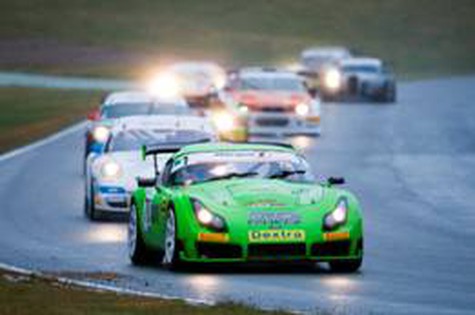 }
}
Danny Winstanley and Matt Seldon Master the Conditions
The sun and heat of Saturday’s free practice and qualifying were distant memories at a distinctly drab Brands Hatch on Sunday, but the GT Cup Championship again produced two dramatic races, and thoroughly entertained the ranks of spectators around the GP circuit.
Race One
The weather was a key variable in both of Sunday’s GT Cup Championship races at Brands Hatch, but it was the rain that began to fall just as the first of the two encounters began that had the biggest impact on the fates of the assembled runners.
It had been spotting for some time as the noontime start approached, but it was only as the cars headed out onto the parade lap that it began to fall sufficiently hard enough for it to be officially declared a wet race. All of the cars were still on slicks, however, and when the pace car headed for the pits, the track surface had become treacherous.
The more powerful Group 1 runners were particularly tentative at the start as they struggled for grip, but the first casualty of the race was the Group 3 Chevron of Andy Yool; the GR8 entering a spin all of its own and hitting the tyre wall on Paddock Hill Bend on the first lap with sufficient force to ensure that it would be taking no further part in proceedings.
The track was so slippery that poleman Michael Saunders considered parking his TVR Cerbera in the opening couple of laps, but he persevered and headed a line of twitchy cars round the 2.43 mile GP circuit. He had lost the lead, though; first, to the #71 Porsche 997 GT3 of Stephen Ritchie; and then – after Ritchie spun at Surtees – to the #45 Group 2 KTM X-Bow of Benjamin Harvey, who appeared to be the only driver enjoying the conditions.
After Rupert Martin’s race in the #49 Ferrari 430 GTC ended with a spin into the pitwall at the end of Lap 1, the officials decided that conditions were such that a caution period was warranted and summoned the safety car onto the track as Harvey began the third lap. With there being such a small amounts of precipitation, only two cars stopped to change to wets, leaving 14 cars on the lead lap when the race went green again with 16 minutes remaining. Harvey in the X Bow made a good restart and started to pull away from his pursuers.
Saunders’ battle with the conditions ended on Lap 6 with a spin into the Paddock Hill gravel, leaving the bright green TVR Sagaris of Danny Winstanley as the new second-placed runner. Soon, however, the first inkling of a dry line was beginning to emerge and the lap times were beginning to fall; and two quick laps from the Sagaris saw the gap from first to second fall to 0.318s.
Tom Andrew had by this point taken the Morgan Aero 8 past Colin Broster’s #15 Porsche to take second in Group 2, but now he was himself being pushed by Gary Eastwood, who was eager to take the Group 1 fight to Winstanley; the TVR having just taken the overall lead from the X-Bow. At the start of Lap 9, Eastwood saw his route past the Morgan and was up to third. Unfortunately, he didn’t see the yellow flag which was being waved while the Cerbera was moved to a place of safety and this would have consequences later on.
More immediately, however, Stephen Ritchie had another spin and dropped his Porsche into the Clarke’s gravel, necessitating a second caution period.
At this point, with seven minutes to go, Harvey’s KTM was the only non-Group 1 car in the top six, but he still held second overall. His six-second advantage over Eastwood had now disappeared, however. Andy Ruhan, meanwhile, had just set the fastest lap of the race so far to close up to third in Group 1. Further back, Mark Radcliffe had just taken advantage of a slow lap from the BMW E46 of Adam Hayes, to snatch the Group 3 lead in his #19 M3.
The safety car pulled off with less than three minutes on the clock, meaning only two more laps would be possible. Eastwood pounced too soon on the restart and passed Harvey before the line, but this time realised his error and back off to allow the positions to reset themselves. But with the track now quickly drying, it wasn’t long before a legitimate pass was completed; Ruhan and the #66 Ferrari 430 of Michael Symons also going by the X-Bow.
Danny Winstanley began Lap 13 with a 1.2 second lead and took full advantage of the clear track ahead to finish the race with a new fastest lap of 1:33.973, and taking the flag for the second time this season 2.096s ahead of Gary Eastwood. Andy Ruhan finished third, a further two seconds back. A steward’s decision post-race would, however, see Eastwood penalised 20 seconds for passing under yellows and this dropped him to fifth in Group 1 and tenth overall, Symons being promoted to third in the process.
Despite losing another place on the final lap, Benjamin Harvey had enough in reserve to take the Group 2 win, with Tom Andrew a close second in the Morgan. Colin Broster took third in Group 2, finishing behind the Invitation BMW E92 of Wayne Gibson.
Mark Radcliffe completed his final two green laps in strong fashion to claim Group 3 honours, with Adam Hayes taking second. Barclay Dougall had had a difficult time in the obviously under-par #37 BMW E46, but his refusal to give up saw him rewarded with third in the group and more valuable championship points.
Race Two
Between the first race ending and the second beginning, the rain began to fall over Kent more forcefully, but this at least meant that wets were the only option as the 16:00 start time approached.
The race began with two laps behind the safety car because of the conditions, the clock starting at the start of the second. When the cars were released, it was Matt Seldon who grabbed the lead at Paddock Hill bend in the Group 1 #23 BMW E46 and held on as the cars sped on out into the woods. Michael Saunders was second in the #99 Cerbera, with Andy Ruhan third in the #6 Porsche 997 GT3; and – there he is again – Benjamin Harvey leading Group 2 and fourth overall in the #45 KTM X-Bow.
As the leaders emerged into Clearways and rounded the Clark Curve, Seldon led by 1.3s, with Ruhan a further second back. Gary Eastwood took fourth from Harvey in the #89 Ferrari along the Brabham Straight, but Danny Winstanley was down in eighth in the Race One-winning Sagaris. Tom Andrew was second in Group 2, but there were five cars between the X-Bow and the Morgan; while Group 3 leader Adam Hayes had the luxury of only one car separating his #9 E46 from Mark Radcliffe’s #19 M3.
Eastwood took third from Ruhan with a bold move down the inside of Paddock Hill Bend at the start of Lap 3 and began the task of closing on the yellow TVR ahead. Saunders, however, had just set the fastest lap to close to within a second of Seldon.
The Group 2 battle looked poised to close up as the Group 1 runners continued to pass Harvey’s X-Bow, but Andrew almost immediately put himself out of contention for group honours by dropping the Morgan into the Druids gravel on Lap 4 and causing the safety car to be scrambled for a third time. The Morgan was recovered and continued without pitting, but the two laps lost were never likely to be recoverable.
The race went green again at the end of Lap 6, with almost exactly ten minutes left on the clock.
Seldon held onto his lead, but the restart was not without significant incident. Andy Ruhan managed to spin the #6 Porsche at Clearways, even before the race went green again, and lost several places; while Mark Radcliffe’s BMW and the #49 Ferrari of Rupert Martin tangled at Surtees on the restart lap. Both were able to continue, but the Group 3 race was settled in favour of Adam Hayes at that moment.
Saunders was once more applying the screws to Seldon and had worked the gap to the leader down to just a quarter of a second by then end of Lap 9, but as the two dived down towards Graham Hill bend on the next lap, the BMW’s rear end seemed to snap out a bit and Saunders took avoiding action. Fortunately for Seldon, he held on and retained the lead; unfortunately for Saunders, he spun and dropped to fourth.
With three minutes remaining, we had two Group battles closing up – Seldon v Eastwood in Group 1 at 1.154s after ten laps, and Harvey v Broster in Group 2 at 2.024. These gaps halved on the next lap, meaning that changes were possible on the final lap.
All eyes were on Clearways as the clock ran out, but it was the BMW that came through first; the Ferrari clearly too far back to make a move in the distance remaining. Matt Seldon took the win by 0.472s from Eastwood, with Danny Winstanley taking third in the #99 TVR Sagaris.
Moments later, it was the X-Bow that emerged from the GP loop with enough of an advantage to take the Group 2 win; Colin Broster falling just 0.546s shy of Benjamin Harvey after a great battle. Francis Galashan took third in the #57 Porsche 996.
Things were less dramatic for Adam Hayes, who took the Group 3 win by 25 seconds from Mark Radcliffe. Barclay Dougall again nursed his ailing E46 to a distant third.
Results:
Race One
Group 1
#78 Danny Winstanley TVR Sagaris 13 laps 25:45.174
#6 Andy Ruhan Porsche 997 GT3 13 laps 25:49.402
#31 Michael Symons BMW GTR E46 13 laps 25:49.597
Group 2
#45 Benjamin Harvey KTM X-Bow GT4 13 laps 25:52.654
#7 Tom Andrew Morgan Aero 8 GT 13 laps 25:54.497
#15 Colin Broster Porsche 996 GT3 13 laps 25:55.010
Group 3
#19 Mark Radcliffe BMW M3 13 laps 25:59.505
#9 Adam Hayes BMW E46 M3 13 laps 26:07.497
#37 Barclay Dougall BMW E46 12 laps
Race Two
Group 1
#23 Matt Seldon BMW E46 12 laps 25:43.980
#8 Gary Eastwood Ferrari 430 GTC 12 laps 25:44.452
#78 Danny Winstanley TVR Sagaris 12 laps 25:47.864
Group 2
#45 Benjamin Harvey KTM X-Bow GT4 12 laps 26:06.132
#15 Colin Broster Porsche 996 GT3 12 laps 26:06.678
#57 Francis Galashan Porsche 996 GT3 12 laps 26:17.752
Group 3
#9 Adam Hayes BMW E46 M3 12 laps 26:26.555
#19 Mark Radcliffe BMW M3 12 laps 26:52.021
#37 Barclay Dougall BMW E46 11 laps
Round four out of nine of the 2011 GT Cup Championship takes place at Snetterton 300 on June 25th/26th.
